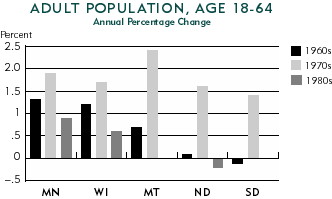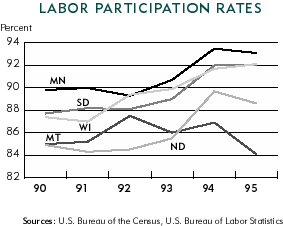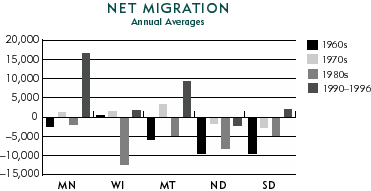As the chamber officials and business leaders quoted in Metro Outlook '98 attest —the Ninth District economy's number one issue is a shortage of labor. Newspapers throughout the district have also been chronicling this growing phenomenon in recent months, and it raises the question: What impact will a tight labor supply have on the Ninth District economy?
Markets exist for workers
One of the virtues of a market economy is its ability to reallocate resources to eliminate both shortages and surpluses. In the case of labor markets, firms demand labor and workers supply it. Labor demand reflects a firm's need for workers—which can be influenced by sales growth and technology—and it follows that, other things equal, employers will demand more workers when wages are low. Correspondingly, the labor supply depends on population size, and the skills and desire of the work force, which will more likely seek jobs when wages are higher rather than lower.
Ideally, labor supply and demand should adjust so everyone who wants to work at prevailing wages could obtain a job, but unemployment rates indicate this ideal is difficult to achieve. At high unemployment rates more workers are willing to work than employers are willing to hire at prevailing wage rates, that is, the quantity supplied is greater than the quantity demanded. At low unemployment rates employers are unable to hire all the workers they desire at prevailing wage rates, thus the quantity demanded is greater than the quantity supplied.
Unemployment rates have fallen
The latter situation is confronting the district as its unemployment rates have been falling in the 1990s and are now well below their historical averages. Moreover, except for Montana, they are well below the national rate.
How have changes in labor demand and supply contributed to the region's shortage of workers? Demand signals are ambiguous. On the one hand, in Minnesota, North Dakota and Wisconsin employment growth in the 1990s was either below or matched its historical average, which suggests no surge in labor demand this decade. In Montana and South Dakota, on the other hand, employment growth was well above historical average.
Supply signals are much clearer. A slowdown in labor force growth appears to account for much of the current gap between labor supply and demand. Nationally, forecasters in the early 1990s anticipated a slowdown in labor force growth. The baby boomers were no longer swelling the labor force, and women's labor force participation had plateaued. In the Ninth District, a tightening in labor supply is no real surprise. The adult population had already declined in the 1980s.

Thus, growth in labor supply appears to have fallen behind the growth in labor demand, and district labor markets are responding as other markets do when a good or service becomes scarce or expensive: Wages have risen. Average hourly earnings in district manufacturing recently have increased at about a 4 percent rate, contrasted with 2.5 percent a couple of years ago. Also, the district's recent wage increases have exceeded the nation's, consistent with a district unemployment rate lower than the nation's.
Businesses reduce dependence on labor
Businesses are seeking to reduce their dependence on labor and to use it more effectively. District firms are substituting capital for labor. Forty-five percent of the respondents to the fedgazette's latest business conditions poll plan to increase their firms' capital spending in 1998, but only 26 percent plan to increase their full-time employment. Firms also are changing how they use workers. For example, while Minnesota's overall employment has increased around 2.3 percent annually between 1990 and 1996, growth in personnel supply services, that is, temporary workers, rose 9.2 percent.
Workers have more incentive to seek jobs
Meanwhile, tight labor markets raise workers' value to businesses, and people's incentive to work and train for jobs is correspondingly increased. As job opportunities open, the participation rate increases, that is, the percentage of adults desiring to work increases. Participation rates in district states, except Montana, increased about 4 percentage points between 1990 and 1995. In addition to legislative changes, for example, tight labor markets undoubtedly contributed to the number of welfare recipients in the district dropping about 33 percent between 1993 and 1997.

Moreover, job opportunities in district states have attracted workers from outside the district. Particularly in the early 1990s, people migrated to the district to take advantage of job opportunities. Except for North Dakota, the district went from an exporter to an importer of people. Montana, especially, experienced a sharp increase in migration. Thus, adult population growth rates improved across the region from the late '80s to mid-'90s.

District businesses may see changes
The district's recent labor shortages may slow economic growth as labor supply and demand adjust, but they are not necessarily jeopardizing the region's expansion prospects. The cost of doing business in the district relative to the rest of the nation, however, may increase. Not only have district manufacturing wages recently risen faster than the nation's, but as people have moved here for work, district housing prices have risen faster than in the nation. Moreover, the tightening labor market may change the nature of economic activity in the region.
Industries that depend on low-cost labor could shrink, but those that use workers more effectively and increase productivity should be able to expand and boost income growth. In addition, tight labor markets suggest enhanced job and income opportunities for district workers.
Consequently, district labor markets are working as intended, and the region is not likely to run out of workers. Nevertheless, labor costs will increase and the structure of the region's economy could change.





